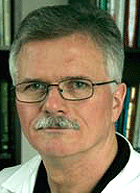Funding from the Missouri Life Sciences Research Fund, part of the 1998 state tobacco settlement, will establish the St. Louis Institute of Nanomedicine Working Group, a collaborative regional effort to apply advances in nanotechnology to the treatment of human diseases.

Wickline
Nanotechnology refers to materials, structures and devices that are smaller than 100 nano-meters, so small that thousands can fit within the dot above the letter “i.” They can be designed to perform useful tasks or functions, including a variety of medical applications.
By bringing together skills and expertise from several area institutions, the institute will promote joint research projects and permit sharing of equipment and other resources. Washington Univer-sity, the University of Missouri-St. Louis, Saint Louis University and St. Louis Community College are among the founding members of the new institute.
“The institute will assemble a broad base of regional expertise in nanotechnology, medicine, technology transfer and education to create novel solutions to complex health-care problems,” said Samuel A. Wickline, M.D., professor of medicine, of physics in Arts & Sciences, of biomedical engineering and of cell biology and physiology. “It will be an inclusive, open network that will cultivate research and improve the ability to translate scientific discoveries into practical applications.”
Wickline, who heads the Siteman Center of Cancer Nanotechnology Excellence, leads the effort at Washington University, along with co-principal investigator Dong Qin, Ph.D., associate dean for research in the Department of Energy, Environment and Chemical Engineering in the School of Engineering & Applied Science.
Also involved as representatives of the other founding institutions are Jingyue Liu, Ph.D., professor of physics and chemistry and director of the Center for Nanoscience at the University of Missouri-St. Louis; Maulik R. Shah, M.D., Ph.D., assistant professor of pediatrics in the Division of Medical Genetics at Saint Louis University Cancer Center; and Richard J. Norris, Ph.D., director of Plant and Life Sciences at St. Louis Community College.
The institute focuses on the development and evaluation of new nanotechnologies for health care; the facilitation of commercialization and testing in patients; and the education of a new workforce and of the public at large.
The collaboration will seek ways to apply nanotechnology to early detection of disease through enhanced imaging of the human body. It will explore the use of nanotechnology for diagnosing disease and delivering drugs to targeted locations such as tumors or atherosclerotic plaques. It also will sponsor projects to evaluate the safety of nanotechnology for medical use.
The grant will fund about four pilot projects each year that will conduct research and train undergraduate and graduate students in the field.
“The pilot projects will expand the portfolio of nanomedicine ideas and attract new talent to the field, effectively increasing the regional nanomedicine infrastructure,” Wickline said.
The Missouri General Assembly allocated $13.4 million to the Life Sciences Research Trust Fund in 2007 and ’08. The Life Sciences Trust Fund was established in the 2003 legislative session. It channels 25 percent of the state’s tobacco settlement proceeds into building life-sciences research capacity.
The St. Louis Institute of Nanomedicine Working Group received $1.5 million for three years for its research and education efforts. Ultimately, the group plans to secure additional support for regional nanotechnology research and training efforts so that the nanotechnology enterprise of the region can expand.